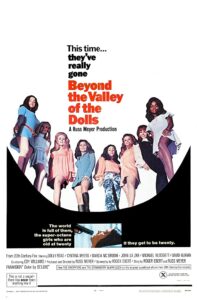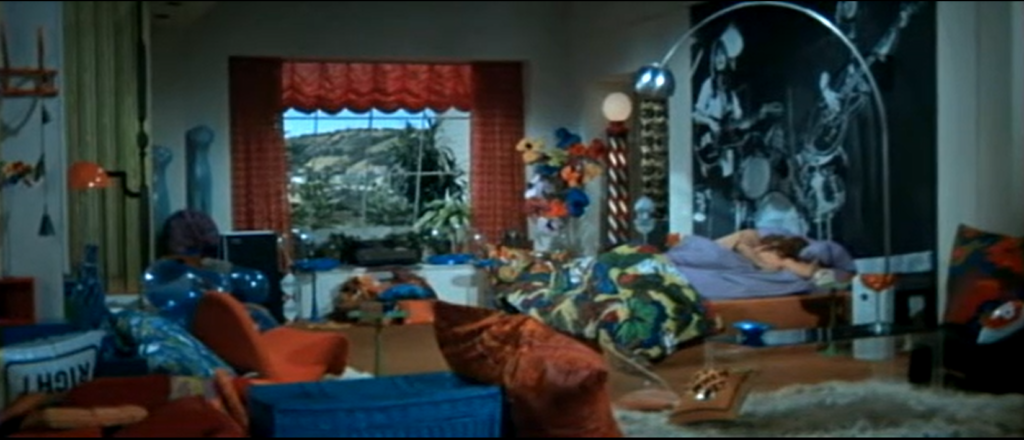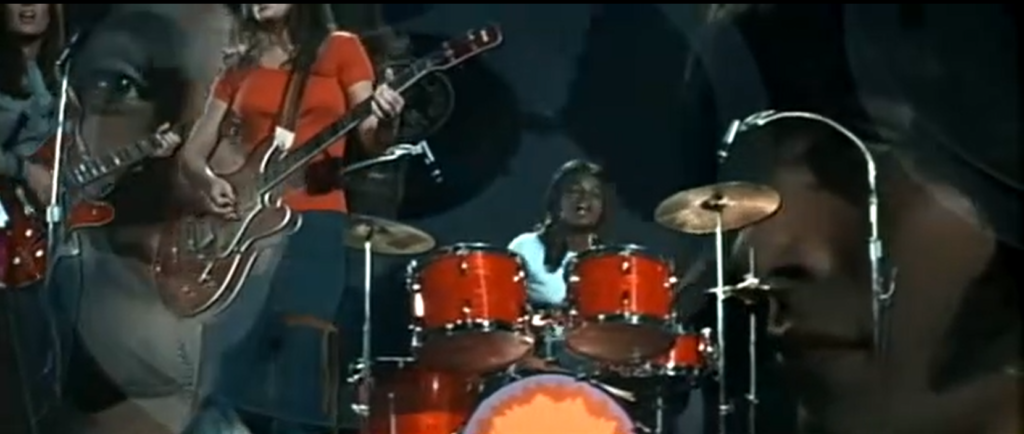Beyond the Valley of the Dolls (1970)
“This is my happening, and it freaks me out!”
|
Synopsis: |
|
Genres, Themes, Actors, and Directors:
Response to Peary’s Review: Peary expands upon his frustrations and disappointment with this film in his first Cult Movies book, where he starts by discussing Meyer’s two cinematic “phases” before BTVOTD: Meyer began as “King of the Nudies”, making a “fortune as the independent producer-director-cameraman-editor-writer-distributor of such cheapie harbingers of the Naked Cinema as the ground-breaking The Immoral Mr. Teas (1959)…” Next he made “infinitely more ambitious” “tongue-in-cheek potboilers” that “served as the basis for the pre-Beyond the Valley of the Dolls cult: Lorna (1964), Mud Honey (1965), … Faster Pussycat, Kill, Kill (1966) … and [Peary’s] favorite, Cherry, Harry, and Raquel (1969).” Peary describes this second string of films — “set in rugged terrains… [and] inhabited by sexually driven buxom beauties…, strong-jawed, no-nonsense heroes, and an assortment of religious zealots, rapists, and sweaty lowlifes” — as “essentially fake morality plays, in which the numerous sinners either repent or are punished severely.” He argues that “as skin flicks, Meyer’s 1964-1969 films were far superior to those of his competitors”, given they are “extremely well-photographed” and feature “wild, absurd visual humor, dialogue that makes no sense…, and ridiculous plot situations — while his actors play their roles straight.” Peary goes on to say that while “to many moviegoers who hadn’t seen a Russ Meyer film, BTVOTD was a revelation — a film that they (mostly college students) considered to be their own ‘far-out’ wave length” — Peary and others realized they’d “overestimated [Meyer’s] talents”. Peary refers to BTVOTD as “really a terrible film, energetically but poorly acted by ex-Playboy bunnies Dolly Reed and Cynthia Meyers, model Marcia McBroom, and under-emoting or overemoting stars.” He points out that “cryptic jargon and Meyer’s rapid-fire editing techniques” (your head will seriously spin!) “are meant to camouflage the picture’s emptiness” — but “the holes in the script come through”. He ends his scathing review (which I essentially agree with) by noting “there is little in [it] to recommend”, and that it simply “proved that what [fans] had seen in his early films were everything Meyer had to offer”; “by choice (!), Meyer returned to making independent sex films — in the Vixen mold but not as good”, which “unfortunately [was] the milieu to which he [was] best suited.” Redeeming Qualities and Moments: Must See? Categories
Links: |



One thought on “Beyond the Valley of the Dolls (1970)”
Must-see, for its one-of-a-kind cult status and as a successful satire. As per my post in ‘Revival House of Camp & Cult’ (fb):
“Ere this night does wane, you will drink the black sperm of my vengeance!”
‘Beyond the Valley of the Dolls’: I first saw Russ Meyer’s rock-cartoon-soap opera-with-claws on its release. In the town bordering mine, it was rather common for the two theaters there to run double-bills as first-runs. ‘Beyond…’ was billed with ‘Myra Breckinridge’.
I was 15 and the MPAA rating system didn’t tend to be enforced where I lived. Still, the fun, young box office gal that I was pals with at The Boyd had qualms about letting me in for two X-rated films. I don’t know how I did it; I may have said something like, “It’s a couple of goofy movies. What am I gonna do afterwards – lead a life of crime?” Whatever I said made her laugh and she let me in.
Sure enough, they were two very goofy movies. I think I had a hard time understanding why they were rated ‘X’ (I don’t recall thinking they were ‘dirty movies’) – but then, I wasn’t a mainstream audience member. I was a curious, nerdy gay kid heavily involved in community theater.
I’ve seen both films a number of times over the years. They have remained goofy – but I tend to rewatch ‘Beyond…’ more regularly. The Criterion (!) blu-ray – with its abundance of entertaining and informative extras – helps to explain why. It’s just a much better movie.
Created as knowing satire with screenwriter Roger Ebert, Meyer made what may be the ultimate movie about The End of the ’60s – when The Love Generation met its demise. In the process, the film’s main source material – Jacqueline Susann’s ‘Valley of the Dolls’ – was pretty much given the heave-ho (Susann was still pissed that her novel was referenced at all) to focus on the music world instead of theater and movies.
Unlike most ’60s movies with music, ‘Beyond…’ has an incredibly catchy pop score (thanks to Stu Phillips) which has held up rather well. Thanks to a very game cast, Ebert’s other-worldly dialogue, Meyer’s remarkable editing and its candy-coated look, the film’s conscious-camp cult status is firmly intact.
I wouldn’t say that watching it again was like seeing an old friend (I’m not sure I would ever have friends like this). However, not only is it Meyer’s best work but there is still no other film remotely like it.
Side Note: I would bet money that the character of Z-Man (based vaguely on Phil Spector) largely influenced Richard O’Brien in his ‘Rocky Horror’ creation of Frank N. Furter.